Diagnostic Tests for Dengue Detection
Diagnostic Tests for Dengue Detection . Dengue fever represents one of the most significant mosquito-borne viral diseases worldwide, with an estimated 390 million infections annually across more than 100 countries.
Early and accurate diagnosis is crucial for proper clinical management and epidemiological control.
This article explores the various diagnostic approaches for dengue detection, their principles, advantages, limitations, and recent advancements in the field.
Introduction to Dengue Virus
Dengue virus (DENV) belongs to the Flaviviridae family and exists as four distinct serotypes (DENV-1, DENV-2, DENV-3, and DENV-4).
Secondary infection with a different serotype can lead to more severe manifestations, including dengue hemorrhagic fever (DHF) and dengue shock syndrome (DSS).
Importance of Accurate Diagnosis
Accurate and timely diagnosis of dengue serves multiple critical purposes:
- Clinical management: Distinguishing dengue from other febrile illnesses with similar presentations
- Surveillance: Monitoring outbreak patterns and prevalence
- Pathogenesis research: Understanding disease mechanisms
- Vaccine development: Evaluating efficacy of preventive measures
- Treatment evaluation: Assessing therapeutic interventions
Classification of Dengue Diagnostic Methods
it can be broadly categorized into:
Direct Methods
1. Virus Isolation
The traditional gold standard involves inoculating patient serum into mosquito cell lines (typically C6/36) or mammalian cell cultures.
While highly specific, virus isolation is time-consuming (7-10 days), requires specialized facilities, and has decreasing sensitivity as the infection progresses beyond the viremic phase.
2. Nucleic Acid Detection
Reverse Transcription Polymerase Chain Reaction (RT-PCR) and its variations (quantitative RT-PCR, real-time RT-PCR) target viral RNA.
These molecular methods offer high sensitivity and specificity during the early viremic phase (1-5 days post-onset).
Newer isothermal amplification techniques like Loop-Mediated Isothermal Amplification (LAMP) have emerged as promising alternatives that require less sophisticated equipment.
3. NS1 Antigen Detection
Non-structural protein 1 (NS1) is secreted by infected cells and can be detected in serum during the early phase of infection.
Enzyme-Linked Immunosorbent Assay (ELISA) and rapid immunochromatographic tests (ICTs) for NS1 have revolutionized early diagnosis, providing results within hours or even minutes.
NS1 detection bridges the gap between direct viral detection and serological methods.
Indirect Methods
These techniques detect the host’s immune response to infection:
1. Serological Tests
Antibody detection remains the most widely used approach, particularly in resource-limited settings:
- IgM Capture ELISA: Detects IgM antibodies that appear 3-5 days after symptom onset and persist for 2-3 months.
- IgG ELISA: Detects IgG antibodies that appear later (7-10 days) in primary infections but rise rapidly in secondary infections.
- IgM/IgG Ratio: Helps differentiate primary from secondary infections.
- Hemagglutination Inhibition (HI): Traditionally used for epidemiological studies, requiring paired sera.
- Plaque Reduction Neutralization Test (PRNT): The gold standard for determining serotype-specific antibodies, though labor-intensive and requiring BSL-2 facilities.
2. Rapid Diagnostic Tests (RDTs)
Immunochromatographic assays for antibodies provide results in 15-30 minutes, making them suitable for point-of-care testing.
However, they generally have lower sensitivity compared to laboratory-based ELISAs.
Diagnostic Challenges and Considerations
Temporal Dynamics of Infection
Different biomarkers appear and disappear at various stages of dengue infection:
- Viremia and NS1 antigenemia: Detectable during early phase (0-7 days)
- IgM antibodies: Appear around day 3-5 and persist for months
- IgG antibodies: Appear around day 7-10 in primary infections; rise rapidly in secondary infections
The optimal testing strategy therefore depends on the timing of sample collection relative to symptom onset.
Cross-reactivity
Serological tests often suffer from cross-reactivity with other flaviviruses (including Zika, yellow fever, Japanese encephalitis, and West Nile viruses), complicating interpretation in areas where multiple flaviviruses co-circulate.
Resource Constraints
Laboratory infrastructure, technical expertise, and financial resources vary significantly across endemic regions, influencing test selection.
Emerging Diagnostic Approaches
Multiplex Assays
These detect multiple biomarkers simultaneously, enhancing diagnostic accuracy. Examples include:
- Combined NS1/IgM/IgG detection systems
- Multiplex RT-PCR for simultaneous detection of all four serotypes
- Platforms that differentiate dengue from other arboviruses with similar clinical presentations
Microfluidic and Paper-based Platforms
Lab-on-a-chip technologies and paper-based analytical devices offer promise for decentralized testing in resource-limited settings, combining sensitivity with simplicity.
Biosensors
Various biosensing platforms utilizing electrochemical, optical, or piezoelectric detection methods are being developed for rapid, sensitive dengue diagnosis.
Proteomic and Metabolomic Approaches
Identification of host response biomarkers through mass spectrometry techniques may yield novel diagnostic targets, particularly for predicting disease severity.
Diagnostic Algorithms and Integrated Approaches
Given the limitations of individual tests, diagnostic algorithms that combine multiple testing modalities based on clinical presentation and timing have been proposed:
- During the acute phase (≤5 days): NS1 antigen detection and/or RT-PCR
- During the post-acute phase (>5 days): IgM/IgG serology
- For comprehensive diagnosis: Combined molecular and serological testing
Future Directions
Several developments are poised to transform dengue diagnostics:
- Next-generation sequencing (NGS): Enabling surveillance of viral evolution and detection of novel strains
- CRISPR-based diagnostics: Offering highly specific nucleic acid detection with potential for field deployment
- Artificial intelligence: Integrating clinical data with laboratory findings to improve diagnostic accuracy
- Wearable biosensors: Allowing continuous monitoring of biomarkers in at-risk populations
Conclusion – Diagnostic Tests for Dengue Detection
Dengue diagnosis has evolved significantly from traditional virus isolation techniques to modern molecular and immunological approaches.
The ideal diagnostic test would combine high sensitivity and specificity with affordability, simplicity, and suitability for point-of-care use.
While current methods have improved our ability to detect dengue, challenges remain, particularly in distinguishing dengue from other febrile illnesses and predicting disease progression.
An integrated approach combining multiple diagnostic modalities, tailored to the specific clinical context and available resources, remains the most effective strategy.
Continued research into novel biomarkers and detection technologies holds promise for further improving our diagnostic capabilities, ultimately contributing to better clinical management and disease control strategies for this important global health threat.

Dr. Shabbir Hussain Bohra (Physio)
Owner & Founder – Physio Talk
Director – HAKIMI Physiotherapy Clinic, Nagpur
Dr. Shabbir Hussain Bohra is a dedicated physiotherapist with seven years of comprehensive experience in rehabilitation and specialized therapeutic care. He holds a Bachelor of Physiotherapy (BPT) degree and has established himself as a leading expert in oncology physiotherapy and lymphedema management. Currently serving as a Consultant Physiotherapist at Asian Kidney Hospital, Nagpur, director hakimi Physiotherapy clinic nagpur Dr. Bohra brings extensive expertise in treating complex medical conditions requiring specialized rehabilitation approaches. His dual specialization as an Onco-Physiotherapist and Lymphedema Therapist enables him to provide targeted care for cancer patients and individuals managing lymphatic disorders.
